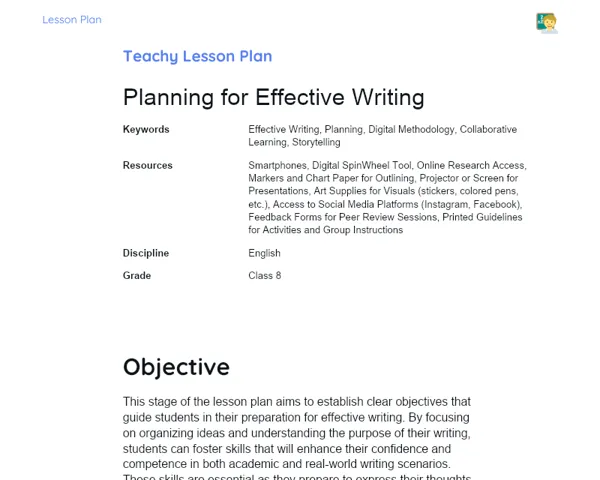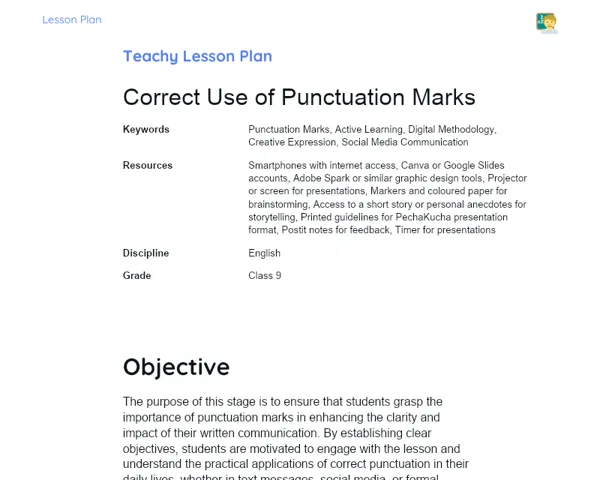Lesson Plan | Active Methodology | Text Structuring and Production
| Keywords | Text Structuring, English, Effective Communication, Hands-on Activities, Group Collaboration, Critical Analysis, Narrative Texts, Emails, Writing Skills, Textual Cohesion |
| Necessary Materials | Diverse texts in English (emails, news articles, stories), Cards with phrases for story building, Writing sheets or papers, Markers or pens, Projector for presentations, Scenario prompts for email writing |
Premises: This Active Lesson Plan assumes: a 100-minute class duration, prior student study both with the Book and the beginning of Project development, and that only one activity (among the three suggested) will be chosen to be carried out during the class, as each activity is designed to take up a large part of the available time.
Objective
Duration: (5 minutes)
This stage is crucial to steer both students and teachers towards the desired learning outcomes. By setting clear objectives, students can leverage their existing knowledge practically during classroom activities. It also helps align expectations and ensures everyone understands what success looks like for the lesson.
Objective Utama:
1. Help students to recognize and effectively use the structure of various types of texts in English.
2. Enhance writing skills to produce clear and well-organized texts in English.
Objective Tambahan:
- Foster students' critical analysis skills when assessing structured texts in English.
Introduction
Duration: (15 - 20 minutes)
The introduction of this lesson aims to engage students by bridging what they already know with the hands-on activities they will undertake. The outlined scenarios prompt students to think critically about applying text structuring in practical situations, while the context highlights the importance of the topic in their lives, enhancing motivation and interest in learning.
Problem-Based Situation
1. Imagine you're journalists for a local newspaper, tasked with writing an article about a significant event at school. How would you structure your write-up to make it both clear and informative?
2. Consider entering a writing competition where the theme is 'My Life in the Future'. How would you organize your thoughts to produce a text that is both imaginative and well-structured?
Contextualization
Understanding how to structure texts is vital not just for academic success but also for effective communication in everyday life and future careers. For instance, knowing how to draft a well-organized email or a presentation can significantly impact the clarity of your message and the perception of your professionalism. Additionally, being aware of how different text types are structured is essential for accurately interpreting information in various scenarios, like understanding manuals, contracts, and articles.
Development
Duration: (75 - 85 minutes)
This development phase is crafted to immerse students in practical scenarios relevant to text structuring in English. By collaborating in groups, students reinforce their learning while developing communication and teamwork skills. This experiential approach aims to enhance knowledge retention and the practical applicability of text structures in diverse contexts.
Activity Suggestions
It is recommended that only one of the suggested activities be carried out
Activity 1 - Structure Detectives
> Duration: (60 - 70 minutes)
- Objective: To help students identify and classify the structure of various types of texts in English.
- Description: In this engaging activity, students will take on the role of detectives investigating text structure. They will be given various texts in English, such as emails, news articles, and short stories, and will need to identify and categorize the structural elements like introduction, body, and conclusion.
- Instructions:
-
Split the class into groups of no more than 5 students.
-
Provide each group with different texts.
-
Ask each group to pinpoint and label the structural components in the text: introduction, body, and conclusion.
-
Students should discuss among themselves why they categorized each part that way.
-
Each group will then present their findings to the class, highlighting the differences in structures of the texts they studied.
Activity 2 - Story Builders
> Duration: (60 - 70 minutes)
- Objective: To practice structuring narrative texts in English, with an emphasis on coherence and cohesion.
- Description: Students will be divided into groups and given cards with mixed-up phrases to build a coherent story. The challenge is not just to arrange them correctly but also to integrate appropriate transitions to ensure the narrative flows smoothly.
- Instructions:
-
Create groups of up to 5 students.
-
Distribute a set of cards with phrases that form a jumbled story to each group.
-
Students are to arrange the phrases logically to construct a coherent story.
-
Once organized, each group should write the story down, adding transitions to connect the ideas fluidly.
-
Each group will present their story to the class, which will critique the narrative's coherence.
Activity 3 - Email Architects
> Duration: (60 - 70 minutes)
- Objective: To improve the skills needed to write clear and structured emails in English.
- Description: In this activity, students will be organized into groups and given different scenarios that require crafting emails. They must think critically about how to structure the email, including a strong introduction, informative body, and clear conclusion.
- Instructions:
-
Divide the class into groups of up to 5 students.
-
Each group receives a unique scenario for an email they need to write.
-
Students brainstorm and finalize the email content.
-
They need to carefully structure their emails, making sure to cover the introduction, body, and conclusion.
-
Each group presents their email to the class, explaining their reasoning behind the structure chosen.
Feedback
Duration: (10 - 15 minutes)
The primary aim of this feedback stage is to consolidate students' learning experiences, allowing them to reflect on the real-world applications of text structures in English while sharing their insights with peers. This discussion reinforces the acquired knowledge, promotes articulation skills in English, and provides the teacher with a chance to assess the students' understanding of the topic discussed.
Group Discussion
At the conclusion of the activities, bring all students together for a group discussion. Begin by asking each group to share their key takeaways from the activities. Encourage dialogue about the different text structures they analyzed and created, and reflect on how these structures can be applied in various English communication scenarios. Use the following prompts to steer the conversation: What were the main challenges faced, and how did you tackle them? In what everyday situations can you apply what you've learned about structuring texts?
Key Questions
1. What are the key elements of a well-structured text in English that you discovered during the activities?
2. How does the structure of different text types (news, email, story) influence the way information is presented?
3. In what ways can practicing text structuring enhance your everyday communication in English?
Conclusion
Duration: (5 - 10 minutes)
The conclusion serves as an important opportunity to solidify students' learning, linking the theoretical insights with the practical exercises undertaken during the lesson. It reinforces the importance of the topic studied, encouraging students to apply what they have learned in real-life situations and to appreciate the value of structuring texts in their educational and professional journeys.
Summary
In this final stage, summarize the core content discussed, highlighting the significance of text structuring in English and its relevance across various contexts, such as writing emails, news articles, and stories. Emphasize the critical characteristics of effective introductions, bodies, and conclusions.
Theory Connection
Discuss how today's lesson intertwined theory with practice, showcasing how the conducted activities enabled students to apply their theoretical understanding of text structuring to real-life challenging situations. Stress how this practical approach supports knowledge retention and preparedness for utilizing these writing skills in English.
Closing
Lastly, underline the relevance of this topic to students' daily lives, emphasizing how the ability to structure texts clearly and objectively is vital for effective communication, not only in academic domains but also in personal and professional spheres. Remind them that continuous practice of these skills will augment their ability to express and comprehend English, which is crucial in our increasingly globalized society.



